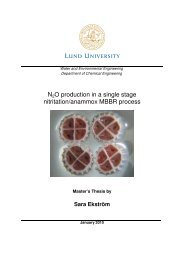Kemira Oyj/Kemira M&I ABSTRACT Vesa Kettunen ... - Svenskt Vatten
Kemira Oyj/Kemira M&I ABSTRACT Vesa Kettunen ... - Svenskt Vatten
Kemira Oyj/Kemira M&I ABSTRACT Vesa Kettunen ... - Svenskt Vatten
You also want an ePaper? Increase the reach of your titles
YUMPU automatically turns print PDFs into web optimized ePapers that Google loves.
Title: A GIS based environmental risk assessment of wastewater pumping station overflows<br />
Name of author: Leena Sänkiaho, M.Sc(Eng.)<br />
Name of the institution: Pöyry Finland Oy, Jaakonkatu 3, 01621 Vantaa, Finland<br />
E-‐mail address to the author: leena.sankiaho@poyry.com<br />
Platform presentation<br />
Language of the platform presentation: English<br />
The Helsinki Region Environmental Services Authority (HSY) operates nearly 500 wastewater<br />
pumping stations around the Helsinki metropolitan area. As HSY is currently renewing its<br />
environmental permit, they are obliged by the environmental authority to conduct an environmental<br />
risk assessment, which reviews the wastewater pumping station overflows. Similar studies have not<br />
been conducted before, hence there are no common guidelines or previous examples of how the study<br />
should be carried out.<br />
To go through all 500 pumping stations individually would have been time consuming and inefficient.<br />
This led to the development of a new geographic information system (GIS) based method. The<br />
presentation will include a description of the method used and how the results can be utilized.<br />
In Finland the Finnish Environment Institute and The National Land Survey of Finland publish free GIS<br />
data. For instance all groundwater areas, lakes, rivers, sea shore and nature reserves are available in<br />
GIS formats. In addition the metropolitan area cities have conducted surveys that map the ecologically<br />
valuable small streams. Beaches can be mapped according to the address details available. HSY<br />
supplied the coordinates of the fresh water intakes. All these data was used as separate risk layers in<br />
the GIS analysis. The layers were rated according to the severity and consequence a sewer overflow<br />
may pose. The rating method has been modified from the rating method used in Water Safety Plans<br />
(WSP) (Bartramet al. 2009).<br />
HSY provided the pumping station coordinates and capacities. The GIS analysis is based on an overlay<br />
operation. If a pumping station overlaps a risk layer, the pumping station will be awarded with the risk<br />
rating.<br />
There are three ways to utilize the results: risk layers, risk sums or risk scores.<br />
Risk layers:<br />
This method detects the pumping stations which are located on certain risk layer. For instance<br />
pumping stations which are located less than 500 m from a beach can be listed and certain risk<br />
prevention methods can be applied to these stations or beaches.<br />
Risk sums:<br />
A risk sum is the aggregated risk rate for each pumping station. It is assumed that a pumping station<br />
will have a higher environmental risk if it is located on more than one risk layer. The values range<br />
from 0 to 6. For instance, the highest risk sum was allocated to a pumping station that is located on a<br />
groundwater area, it is also on the buffer zone of a groundwater well (< 500 m) and less than 100 m<br />
radius from an ecologically valuable small stream.<br />
Risk scores:<br />
It is assumed that the overall risk is also related to the pumping station capacity as the pumping<br />
station capacities vary from 3 l/s up to 2000 l/s. Therefore the risk sums were weighted by the
















